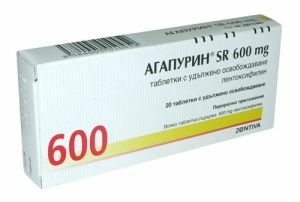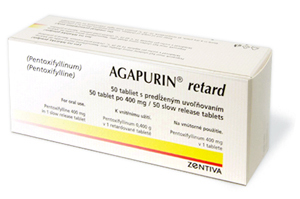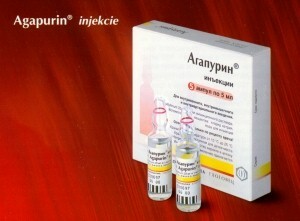 Agapurin is a medicinal product from the group of purines, which improves rheological properties and microcirculation of blood.
Agapurin is a medicinal product from the group of purines, which improves rheological properties and microcirculation of blood.
Refers to spasmolytic and vasodilating agents. Produced in the form of long-acting tablets, white. The active substance is pentoxifylline 400 mg or 600 mg.
Auxiliary components:
- tablet core - povidone 40, magnesium stearate, hypromellose 2200/15000, talc;
- tablet shell emulsion dimethicone, sepiphilm 752 white, macrogol 6000.
Contents
- Pharmacological action
- Pharmacokinetics of the preparation
- Indications for use
- Contraindications to admission
- Mechanism of action
- Instruction for use
- Dosage and methods of application
- Overdose and additional indications
- Side effect
- Interaction with other drugs
- Reception during pregnancy
- Additional information
- From practical experience
- opinion
- opinion
- 's reviews Pros and cons of
- Drug medication
- Similar drugs
Pharmacological action
Active ingredient Agapurin - pentoxifylline - improves blood microcirculation, relaxes and protects the vessel wall, reduces blood viscosity, promotes resorption of blood clots, reduces the level of fibrinogen inblood, inhibits the ability of erythrocytes to bind together.
With its antispasmodic effect, the drug effectively removes pain and night cramps in the muscles of the limbs.
It improves oxygen delivery to the tissues of the central nervous system and improves bioelectrical activity between them. Prevents oxygen starvation of tissues.
Pharmacokinetics of the preparation
Pentoxifylline is rapidly absorbed from the stomach and intestines and enters the liver where the "first pass" passes, dividing into 2 active metabolites: metabolite I and metabolite V.
Their concentration in the blood is several times greater than pentoxifylline and reaches itsmaximum 2 hours after admission. The medicine is excreted from the body mainly by the kidneys and in a small amount by the intestine.
Indications for use
Agapurin is prescribed in the following diseases and conditions:
- impairment of cerebral circulation in ischemic and post-postpoxic conditions;
- cerebral atherosclerosis;
- viral neuroinfection;
- circulatory disturbance in the vessels of the eye;
- condition after myocardial infarction;
- impotence of vascular genesis;
- violation of peripheral circulation as a result of atherosclerotic inflammatory and diabetic processes;
- disturbances of trophism of tissues against the background of frostbite, trophic ulcers of the lower leg, varicose veins, gangrene, post-thrombotic syndrome;
- Raynaud's disease;
- cerebral blood flow insufficiency;
- ischemic heart disease;
- bronchial asthma;
- otosclerosis.
About trophic ulcers in detail:
Contraindications to admission
The drug Agapurin is contraindicated in the following cases: 
- acute myocardial infarction;
- hemorrhage in the ocular membrane;
- marked cerebral or coronary atherosclerosis;
- massive bleeding;
- hemorrhagic stroke;
- heart rhythm disturbances;
- sensitivity to pentoxifylline or other components of the drug.
Mechanism of action
The principle of pentoxifylline is associated with an increase in the content of ATP in erythrocytes and cyclic AMP in platelets.
Simultaneously, the phosphodiesterase is suppressed and the energy potential is saturated, which leads to a decrease in peripheral vascular resistance, vasodilation, an increase in the minute and stroke volume of the blood without any change in the frequency of cardiac contractions.
Expanding the blood vessels of the lungs, pentoxifylline helps enrich the blood with oxygen, and coronary arteries - improves its delivery to the myocardium. By acting on red blood cells, it increases the elasticity of their membranes and reduces the viscosity of the blood.
Instruction for use
Agapurin is available in the form of tablets and ampoules with a solution for injection:
- Tablets of white color , coated with 400 mg and 600 mg. Biconvex, oval, with risk for division on one side.
- Solution for injection is available in ampoules of 100 mg. One ampoule contains 20 mg of pentoxifylline.
Dosage and methods of use
Tablets are recommended to be taken orally after meals.400 mg - 2-3 times a day, 600 mg - 2 times a day. The daily dose should not be more than 1200 mg.
Drug in the form of a solution is usually administered as follows: 
- Intraarterially .1 ampoule dissolved in 20-50 mg isotonic sodium chloride. With prolonged therapy, it is possible to increase the dose to 2-3 ampoules;
- Intravenous .1 ampoule diluted in 250-500 ml of 5% glucose solution or 0.9% sodium chloride. The drug is administered slowly - no more than 150 ml per hour;
- Intramuscular .100 mg 1-2 times a day. As a rule, the contents of the ampoule are not diluted.
Overdose and additional indications
In case of an overdose, the following symptoms are observed:
- central nervous system : general weakness, impaired coordination, dizziness, unconsciousness, convulsive syndrome, nausea;
- cardiovascular system : lowering of blood pressure, violation of heart rhythm, redness of the skin in the face and neck;
- breathing disorder ;
- body temperature increase ;
- vomiting with blood impurities .
Adverse effects of
Drug administration can cause such negative consequences:
- digestive system : dry mouth, loss of appetite, intestinal atony;
- cardiovascular system : arrhythmia, lowering of pressure, tachycardia;
- circulatory system : thrombocytopenia, leukopenia, bleeding from the intestine, stomach, subcutaneous capillaries;
- nervous system : anxiety, dizziness, sleep disturbances, convulsions, headaches;
- skin : hyperemia of the facial skin, brittle nails, edema;
- sensory organs : visual disturbance, scotoma;
- allergy : itching, anaphylactic shock, Quincke's edema, urticaria.
Interaction with other drugs
The use of agapurin with insulin, drugs that reduce blood pressure and promote blood clot resorption, valproic acid or antidiabetics enhances their effectiveness.
Interaction of the drug with Methylxanthine leads to nervous excitability, and with cimetidine - an increase in the concentration of pentoxifylline. Decrease in the effectiveness of the drug occurs with the simultaneous administration of tobacco or its derivatives.
Admission during pregnancy
It is strongly contraindicated to take medicine for pregnant women, and also during breastfeeding. The safety of its reception by children is not established, although most doctors do not recommend giving medicine to patients who have not reached the age of 15-18.
Additional instructions
 During treatment, it is necessary to regularly check blood pressure. Patients with impaired renal function increase the amount of medicine gradually. They need constant monitoring of the attending physician, since in case of a hemorrhage in the eye, it is immediately canceled.
During treatment, it is necessary to regularly check blood pressure. Patients with impaired renal function increase the amount of medicine gradually. They need constant monitoring of the attending physician, since in case of a hemorrhage in the eye, it is immediately canceled.
It is also not recommended to take medicine in large numbers of people with diabetes who use hypoglycemic drugs. This can cause hypoglycemia.
Patients who have undergone recent surgical procedures, when using the drug, should monitor the level of hematocrit and hemoglobin in the blood.
From the practical experience of using
The reviews of doctors and patients who took Agapurin are rather ambiguous. You can learn more about them below.
View of doctors
Sergey Viktorovich
Katerina Valerievna
Nikolai Petrovich
Patient feedback
Roman
Valentina Nikolaevna
Oksana
Tips from patients:
- Take the drug only in the amount that was prescribed for h. Once I drank one more tablet, I felt nauseated and dizzy.
- is best for taking medicine after eating .When I drank the pills before eating, my stomach began to ache.
Pros and Cons of
Given the feedback from doctors and patients, Agapurin has more advantages than disadvantages. The disadvantages of this drug are associated with its strong effect, and hence - a number of side effects in overdose.
Also, it should not be taken to nursing mothers and pregnant women. It is unknown its effect on children, which is also a big minus.
At the same time, Agapurin is highly effective. Most doctors recommend taking it for any vascular disease.
Cost of medicine
Price for Agapurin in tablets 400 mg varies from 250 to 350 rubles, 600 mg - from 450 to 550 rubles .depending on the pharmacy and the location of the  purchase.
purchase.
Solution for injections in ampoules has about the same price in accordance with the dosage of the drug.
The shelf life of Agapurin is 3 years. It is stored in a dry place at a temperature of no more than 25 ° C.
Agapurin is only available on prescription.
Similar preparations
There are several drugs with the same active substance as in Agapurin.
To domestic medicines belong Pentoxifylline and Trental.
From foreign it is worth noting German Pentoxifylline-Ratiofarm, Trental of Indian and French production and Austrian Vazonite.
